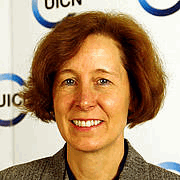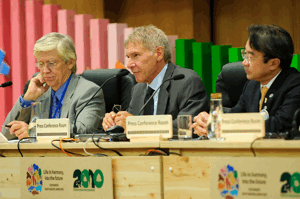Biodiversity Convention
Air Date: Week of November 5, 2010
 |
It was a tense, last minute negotiation but, at the bottom hour, diplomats from the 193 nations who attended the 2010 Convention on Biological Diversity in Nagoya, Japan finally came to an agreement. Jane Smart of the International Union for the Conservation of Nature tells host Bruce Gellerman that the parties agreed to 20 targets to hold off the loss of biodiversity and to pay countries for the use of their resources.
Transcript
GELLERMAN: It’s Living on Earth, I’m Bruce Gellerman.
CURWOOD: And I’m Steve Curwood. Scientists say the planet is losing species at a rate not seen in 65 million years, not since the massive dinosaur die-off. Now, after 18 years of intensive, international negotiations designed to save the world’s biodiversity, diplomats have finally come up with an agreement.
GELLERMAN: Negotiators from 193 nations met in Nagoya, Japan. Two weeks of round-the-clock discussions came down to a middle of the night, nail-biting session that led to the historic deal. Jane Smart was at the UN Convention on Biodiversity summit. She’s Director of the Biodiversity Conservation Group at the International Union for the Conservation of Nature. Dr. Smart joins me from Geneva, Switzerland. Welcome to LOE!
SMART: Thank you very much!
GELERMAN: I understand it was a frantic night of last minute negotiations. Were you up at two am when it concluded?
SMART: Oh, yes, I was in the room. It was all very, very exciting seeing this big step forward for nature.
GELLERMAN: Actually, as I understand it, it’s three steps forward!
SMART: Three steps forward. So, on the table, there was a kind of a package deal: the big plan to save nature, to be achieved by 2020, a new protocol for access to genetic resources, and also a big plan to pay for everything. And, the parties had agreed that they would go for all three or nothing. So, that required quite a lot of negotiation, right up until the last minute.
GELLERMAN: Let’s call about the protocol- the Nagoya Protocol, it’s being called now- this notion of sharing the access to genetic resources.

Jane Smart is director of the Biodiversity Conservation Group at the International Union for the Conservation of Nature.
SMART: Yes, so for a long time the developed world, the North mostly speaking, has enjoyed access to the biodiversity, or the nature, the species occurring in developing countries. And, there’s been no payback for those countries. So, what’s really positive about this new protocol is that there now has to be a payback.
So if a company wants to take, I don’t know, a species of fungus or a species of mammal or frog and isolate a chemical from it, and develop a drug, for instance, they’re now going to have to negotiate with that country a fair deal for the sharing of the benefits- in other words, money.
GELLERMAN: Let’s talk about saving nature. They came up with 20 specific targets, as I understand it.
SMART: That’s right, 20 targets for 2020, to try and hold the loss of biodiversity or nature in ten years time.
GELLERMAN: Well, previously, they were supposed to save something like 10 percent of the oceans by 2012, so far I think it’s one percent.
SMART: Yeah, that’s a pretty dismal one, cause that was a target set and not reached. And we’re at one percent of that seventy percent of the planet that is ocean. But, a new target has been set for ten percent by 2020, and actually, that’s not a bad target. So, actually we have to increase by ten times what we have now. And the way around this is to set up marine protected areas and ensure that, you know, we enforce the protection of those areas to bring back fish stocks from near collapse, in some cases.
GELLERMAN: How much land do they want to protect?
SMART: On the land, the target is a little bit weak. It says 17 percent. And, sometimes places have reached that already. The current value globally is around 13 percent, so that isn’t as ambitious as we would have liked it at IUCN, we would have like to have seen a bit… a more… a further stretch on that one.
GELLERMAN: Somebody is going to have to pay for all of these ambitions. How much money is on the table and how much money is going to be needed?
SMART: Clearly, we need more money. I mean, at the moment it’s pretty dismal. So we have three billion a year, US dollars, going into biodiversity-related aid, is the technical term. Clearly, this amount needs to increase.
GELLERMAN: Japan came up and pledged, what, two billion dollars. Why would they do that?
SMART: I think Japan really wanted a success, and that’s great. You know, I’m so glad that Japan is meeting because they really, really wanted this to work, and without their leadership, it wouldn’t have worked. Um, as you know, the US is not a party to the convention. That’s a great shame, everybody involved feels it would be a wonderful if the US were to ratify the biodiversity convention.

The U.S. is not a signatory to the biodiversity talks. Conservation International's vice chairman, Harrison Ford, has called on the U.S. to get involved. (© CI/photo by Haja Rasambainarivo)
GELLERMAN: I hear a ‘but’ there.
SMART: Well, they were in the room. Interestingly, people from the US were there, but I think the process for ratifying conventions in the US, as I understand it, is quite long and involved. I think, well, IUCN and other organizations have to keep applying a little pressure in the hope that President Obama will place us up on the list of his priorities.
GELLERMAN: Can a plan to hopefully save the word’s biodiversity by 2020- can that have any hope of success without the United States?
SMART: That’s a very good question. Well, the United States is going to have to play ball in some way or another because the access and benefit sharing protocol will apply to the recipient countries that they want to go into and take biodiversity from, if you like. So the idea is to bring to a halt, this so-called bio-piracy. And I think the United States, whether they’ve ratified the convention or not, will be subject to those laws as they gradually come into place.
GELLEMAN: It’s taken 18 years of intensive negotiations to get where we are now coming up with targets. How confident are you that ten years from now we’ll be able to see tangible results from this conference, that they’ll meet the targets?
SMART: Well, you know, I think in my business, working for IUCN, you have to be a bit of an optimist. Your glass has to be half full. And, although we’ve failed, let’s be honest, we’ve failed in 2010 to meet the so-called 2010 target, as I say- I’m more ambitious this time around because there’s been more buy-in, I would say, by governments- more understanding of the issues.
The imperative is there. You can feel that people are starting to understand what might happen if we don’t meet these targets, which is reaching these so-called tipping points and seeing big changes in ecosystem functioning that really will impact us and the way we live. It’s already happening.
If we think of the Pakistani floods, there’s no doubt that deforestation made the impact of those far worse. The tsunami wouldn’t have been so damaging to people had the mangrove not been so destroyed in that part of Asia. And, there are many, many other examples like this, and the knowledge is starting to, I think, have traction with governments.
GELLERMAN: Dr. Smart, thank you very much.
SMART: You’re most welcome!
Links
Living on Earth wants to hear from you!
Living on Earth
62 Calef Highway, Suite 212
Lee, NH 03861
Telephone: 617-287-4121
E-mail: comments@loe.org
Newsletter [Click here]
Donate to Living on Earth!
Living on Earth is an independent media program and relies entirely on contributions from listeners and institutions supporting public service. Please donate now to preserve an independent environmental voice.
NewsletterLiving on Earth offers a weekly delivery of the show's rundown to your mailbox. Sign up for our newsletter today!
 Sailors For The Sea: Be the change you want to sea.
Sailors For The Sea: Be the change you want to sea.
 The Grantham Foundation for the Protection of the Environment: Committed to protecting and improving the health of the global environment.
The Grantham Foundation for the Protection of the Environment: Committed to protecting and improving the health of the global environment.
 Contribute to Living on Earth and receive, as our gift to you, an archival print of one of Mark Seth Lender's extraordinary wildlife photographs. Follow the link to see Mark's current collection of photographs.
Contribute to Living on Earth and receive, as our gift to you, an archival print of one of Mark Seth Lender's extraordinary wildlife photographs. Follow the link to see Mark's current collection of photographs.
 Buy a signed copy of Mark Seth Lender's book Smeagull the Seagull & support Living on Earth
Buy a signed copy of Mark Seth Lender's book Smeagull the Seagull & support Living on Earth

